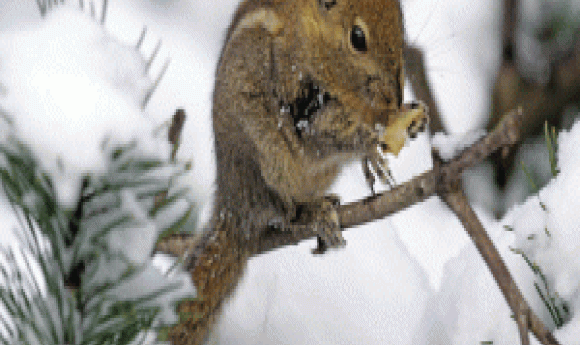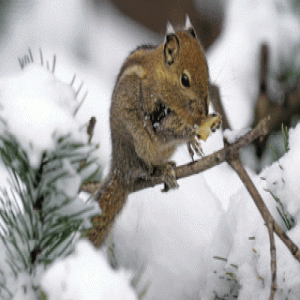Braving the cold: How do squirrels and other rodents hibernate?

In the coldest months of winter, some furry rodents survive by hibernating. How do squirrels’ and other rodents’ special neurons allow them hibernate?

Snow falls from the sky, and people walk around bundled up in scarves and puffy jackets. Without the benefit of these accessories, some rodents like squirrels brave the coldest months by hibernating. Recently, a group of scientists led by Elena Gracheva at Yale University made the surprising discovery that certain rodents possess cold-insensitive neurons that allow them to hibernate. Their study, published in Cell Reports, characterized how the TPRM8 ion channel confers cold insensitivity to those neurons.
Gracheva’s group became interested in studying rodent hibernators because they were curious about the unique physiology that allows for hibernation. “Our initial hypothesis was that animals that hibernate have to be cold-tolerant. Otherwise they can’t hibernate,” said Gracheva. “When we feel cold, we are not able to sleep because our bodies tell us that we need to warm up first…Hibernators must have some special component that interacts with the environment and makes them cold-insensitive.”
Gracheva and her team turned to the TRPM8 channel, which they knew was involved in sensing cold in many different types of rodent neurons, including hibernators like squirrels and Syrian hamsters and non-hibernators like mice and rats. They wanted to characterize–on both a behavioral and molecular level–how hibernators and non-hibernators differ, and to test whether making changes to the TRPM8 channel would affect their cold sensitivity.
The team tested behavior by observing rodent preference for a warm or cold plate. Non-hibernating rats and mice repeatedly showed a strong preference for the warm plate, while hibernating ground squirrels and hamsters showed no preference for either plate, unless the cold plate fell below 5 degrees C.
Gracheva’s team next isolated neurons from the hibernating and non-hibernating rodents and tested whether these neurons would activate in response to decreasing temperatures. They also used patch-clamp experiments to observe the activity of individual TRPM8 channels. The neurons and TRMP8 channels from hibernating rodents were less sensitive to cold compared to those from the non-hibernating rodents.
Suspecting that the structure of the TRPM8 channel was responsible for these differences, Gracheva and her team investigated whether there were molecular differences in the channel between the different types of rodents. When analyzing the amino acid sequences, they found that six amino acids in a transmembrane region differed between the TRPM8 channels of hibernators and non-hibernators. When the team substituted this sequence in rat channels with the hibernating squirrel version, the rat TRPM8 lost its cold sensitivity. On the other hand, introducing the rat sequence into the squirrel channel made the squirrel TRPM8 cold-sensitive.
“[Gracheva] was able to find the mutation that helps convert cold-insensitive TRPM8 to cold-sensitive TRPM8,” said Seok-Yong Lee from Duke University, who was not involved in the study. “Not only did her studies show how molecular adaptation could confer cold tolerance to some organisms for their survival, but also her studies provide a clue to cold sensing by TRPM8 by showing that all key sites are localized to a transmembrane region.”
Gracheva believes that there are many applications for this work on TRPM8 channels and cold sensitivity. For instance, understanding how organisms like rodent hibernators survive cold temperatures could help us in developing better ways to preserve organs for transplantation. Furthermore, the process by which animals go in and out of hibernation relates to induced hypothermia for treating stroke and heart attack patients.
“It’s a really exciting time in science to work outside the mouse box,” said Gracheva. “We can learn from non-standard animal models a lot, and potentially learn about our own bodies.” Gracheva hopes to further investigate the molecular mechanism of TRPM8 in different rodent models. For now, though, these furry creatures will just be trying to get through the cold like the rest of us.